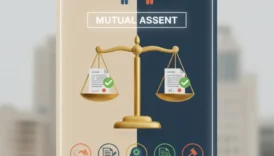Offer and Acceptance: Key Contract Principles

- Offer and Acceptance: Key Contract Principles
- Introduction
- Legal Definition of an Offer
- Essential Characteristics of a Valid Offer
- Clear and Definite Terms
- Intention to Create Legal Relations
- Communication to the Offeree
- Capable of Acceptance
- Legal Certainty
- What Constitutes Acceptance in Contract Law
- Key Features of Valid Acceptance
- Quick Reference Table
- Rules Governing Valid Acceptance
- 1. The Mirror Image Rule
- 2. Communication Requirement
- 3. The Postal Rule
- 4. Electronic and Digital Acceptance
- 5. Timing and Revocation
- Quick Comparison Table
- The Role of Communication in Offer and Acceptance
- Why Communication Matters
- Key Rules of Communication
- Practical Examples
- Offer vs. Invitation to Treat
- What Is an Invitation to Treat?
- Legal Significance
- Case Examples
- Practical Comparison
- Termination and Revocation of Offers
- Ways an Offer Can Be Terminated
- Quick Reference Table
- Case Examples and Judicial Interpretations
- Carlill v Carbolic Smoke Ball Co (1893)
- Pharmaceutical Society of Great Britain v Boots (1953)
- Hyde v Wrench (1840)
- Entores Ltd v Miles Far East Corp (1955)
- Lessons from Case Law
- Offer and Acceptance in Modern Commerce
- Online and Digital Contracts
- E-commerce Transactions
- International Business Deals
- Practical Challenges in the Digital Age
- Quick Comparison Table
- Conclusion
- FAQs About Offer and Acceptance
- What is the difference between an offer and acceptance?
- Can silence count as acceptance in contract law?
- What is the mirror image rule in acceptance?
- Are advertisements considered offers?
- What is the postal rule in contract law?
- How are online contracts accepted?
- Can an offer be revoked after acceptance?
- What happens if an offer lapses?
Introduction
Contract law rests on a few foundational principles, and none are more essential than offer and acceptance. These two elements form the building blocks of any legally binding agreement, determining when negotiations become enforceable obligations. While consideration adds value and legality ensures compliance with public policy, it is offer and acceptance that establish the very existence of a contract.
In simple terms, one party makes an offer, setting out clear terms, and the other provides acceptance, signifying agreement. When these two align, the law recognizes that a “meeting of the minds” has occurred, creating enforceable obligations.
This article explores the legal meaning of an offer, the characteristics of valid offers and acceptances, the rules governing communication, and how modern commerce—particularly online transactions—has reshaped these principles. By the end, you will understand why offer and acceptance are often described as the heart of contract law.
Legal Definition of an Offer
In contract law, an offer is a clear and definite proposal made by one party to another, demonstrating the intention to be legally bound once the offer is accepted. It sets out the essential terms of the agreement and creates the foundation upon which acceptance can build a contract. Unlike a casual statement or invitation, a valid offer signals readiness to enter into enforceable obligations.
An offer must show two key elements: serious intent and communication to the offeree. Serious intent means the offeror genuinely intends the proposal to form a contract if accepted, not as a joke, negotiation tactic, or social courtesy. For example, offering to sell a car for $10,000 in a formal email constitutes an offer, but saying the same thing jokingly at a party does not.

Communication is equally vital. An offer cannot bind someone who never received it. Courts have consistently ruled that until the offeree is aware of the terms, no contract can arise. For instance, a reward poster for a lost pet becomes an offer to the public, but only once people see it and understand the conditions.
Another key distinction is between offers and invitations to treat. While offers can be accepted to form a binding contract, invitations merely invite negotiation. Advertisements and shop displays are often classified as invitations to treat unless they show clear intent to be binding.
Ultimately, the legal definition of an offer is precise: it is a proposal made with the intent to be bound, communicated to the offeree, and containing sufficiently clear terms to be enforceable once accepted.
Essential Characteristics of a Valid Offer
For an offer to be legally recognized and capable of forming a contract, it must meet specific requirements. Courts examine these characteristics to distinguish serious contractual proposals from casual statements or negotiations. A valid offer provides clarity, demonstrates intent, and allows the offeree to make an informed decision about acceptance.
Clear and Definite Terms
An offer must be precise enough for both parties to understand their obligations. Vague or uncertain terms are generally unenforceable. For instance, saying “I’ll sell you a car at a fair price” is too ambiguous, while “I’ll sell you my 2020 Toyota Camry for $12,000” sets clear conditions that can be accepted. Courts require enough detail for performance and breach to be measurable.
Intention to Create Legal Relations
A valid offer must be made with the intent to be legally bound if accepted. This excludes social or domestic agreements, such as a parent promising a child extra allowance. In business or commercial contexts, however, there is usually a presumption of intent unless evidence shows otherwise. This principle ensures that contracts are formed only where enforceability is genuinely intended.
Communication to the Offeree
An offer must be effectively communicated to the person or group it is directed at. An uncommunicated offer cannot be accepted. For example, if a company internally drafts a promotional offer but never publishes it, customers cannot claim its benefits. Communication may be direct (letters, emails, verbal statements) or indirect (public advertisements with clear binding intent).
Capable of Acceptance
A valid offer must be structured in a way that allows acceptance without further clarification. If the terms require additional negotiation, they may be treated as invitations to treat rather than binding offers. For instance, displaying goods on a store shelf generally invites customers to make offers, rather than constituting offers themselves.
Legal Certainty
The offer must not involve illegal activities or impossible obligations. An agreement to perform unlawful acts, even if communicated clearly, cannot be considered a valid offer. This requirement preserves the integrity of contract law and ensures that contracts support lawful objectives.
“The strength of a contract begins with the clarity and seriousness of the offer.”
What Constitutes Acceptance in Contract Law
Acceptance is the final step that transforms an offer into a binding contract. To be valid, acceptance must demonstrate clear agreement, follow specific legal rules, and be communicated properly to the offeror. Courts consistently emphasize that acceptance is not just agreement—it is agreement on the exact terms of the offer.
Key Features of Valid Acceptance
1. Unqualified and Unequivocal Agreement (Mirror Image Rule)
- Acceptance must match the offer exactly.
- Any change, no matter how small, converts it into a counteroffer rather than true acceptance.
- Example: If A offers to sell a car for $10,000 and B replies, “I’ll take it for $9,500,” this is not acceptance—it is a counteroffer.
2. Communication to the Offeror
- Acceptance must be communicated clearly.
- Silence alone is not acceptance unless paired with conduct that shows intent.
- Example: Using a subscription service after being informed of terms can amount to acceptance by conduct.
3. Acceptance by Conduct
- Not all contracts require words; actions can show acceptance.
- Common examples include:
- Paying at checkout.
- Clicking “I agree” in online contracts.
- Boarding a bus after seeing the posted fare.
4. Authorized Acceptance
- Only the person (or group) the offer is directed at can accept it.
- Third parties cannot accept unless explicitly authorized.
- Example: A job offer made to a candidate cannot be accepted by a friend or relative.
5. Timing of Acceptance
- Acceptance must occur while the offer is still valid.
- An offer may end through:
- Expiration of time.
- Revocation by the offeror.
- Rejection by the offeree.
- Death of the offeror.
Quick Reference Table
| Rule | Requirement | Example |
|---|---|---|
| Mirror Image Rule | Acceptance must match terms exactly | Changing the price = counteroffer |
| Communication | Must reach the offeror | Email reply confirming agreement |
| Conduct | Actions show acceptance | Clicking “I agree” |
| Authorized Person | Only intended offeree can accept | Candidate accepting job offer |
| Timing | Must occur before lapse/revocation | Accepting within valid period |
“Acceptance is the decisive moment when negotiations crystallize into binding obligations.”
Rules Governing Valid Acceptance
Acceptance is not valid simply because one party says “yes.” Contract law imposes specific rules to ensure fairness, clarity, and enforceability. These rules govern how, when, and under what conditions acceptance is recognized as binding.
1. The Mirror Image Rule
- Definition: Acceptance must match the offer in every respect.
- Why it matters: Any alteration turns acceptance into a counteroffer.
- Example: If a seller offers a laptop for $1,000 and the buyer says, “I’ll pay $1,000, but only if you include a free case,” this is a counteroffer, not acceptance.
2. Communication Requirement
- Acceptance must be communicated clearly to the offeror.
- Silence is generally not considered acceptance, unless:
- The offeree’s conduct shows agreement (e.g., continued use of a service).
- Prior dealings between the parties establish that silence signals consent.
- Courts stress that both parties must be aware of the contract’s terms.
3. The Postal Rule
- Definition: Acceptance is effective once it is posted, not when received.
- Example: If a buyer mails a letter of acceptance, the contract is formed the moment the letter is sent—even if it gets delayed.
- Modern limits: Courts restrict this rule in email and online communication, where instant delivery is expected.
4. Electronic and Digital Acceptance
- In modern commerce, acceptance often occurs online.
- Common examples:
- Clicking “I agree” to terms of service.
- Completing online checkout with a “Confirm Purchase” button.
- Courts treat these digital actions as valid acceptance, provided terms are clearly presented.
5. Timing and Revocation
- Acceptance must be made before the offer lapses.
- Offers can end due to:
- Revocation by the offeror (before acceptance).
- Rejection by the offeree.
- Expiry of time stated in the offer.
- Any acceptance after expiration or revocation is invalid.
Quick Comparison Table
| Rule | Requirement | Example |
|---|---|---|
| Mirror Image Rule | Terms must match exactly | Buyer changing terms = counteroffer |
| Communication | Must be clear to offeror | Reply email confirming offer |
| Postal Rule | Effective when posted | Mailed acceptance forms contract |
| Electronic Acceptance | Online actions as acceptance | Clicking “I agree” |
| Timing | Before lapse/revocation | Accepting before offer withdrawn |
“The rules of acceptance ensure that contracts are formed with clarity, certainty, and fairness.”
The Role of Communication in Offer and Acceptance
Communication is at the heart of contract formation. Even if the offer and acceptance exist in theory, a contract cannot be binding unless both are effectively communicated. This principle ensures that parties know exactly what they are agreeing to and when obligations arise.
Why Communication Matters
- Ensures clarity: Both sides understand the terms.
- Creates certainty: The moment of contract formation is identifiable.
- Prevents disputes: Reduces the risk of one party claiming ignorance of the agreement.
Key Rules of Communication
1. Communication of Offer
- An offer must be clearly conveyed to the offeree.
- If the offeree is unaware of the offer, they cannot accept it.
- Example: A reward for a lost dog is enforceable only if the person claiming it saw the poster before returning the dog.
2. Communication of Acceptance
- Acceptance must usually be communicated directly to the offeror.
- Silence is not acceptance, unless conduct clearly shows consent.
- Example: A tenant paying rent after lease renewal terms are sent may indicate acceptance by conduct.
3. The Postal Rule
- In traditional law, acceptance is effective once it is posted.
- This rule prevents delays or losses in the mail from defeating contracts.
- However, courts are cautious about applying it to instant digital communication.
4. Modern Electronic Communication
- Today, acceptance often occurs through emails, apps, or websites.
- Courts generally apply the rule that acceptance is valid when received, not when sent, unless terms specify otherwise.
- Examples:
- Clicking “Accept” in an online contract.
- Confirming an order via email.
5. Silence as Communication
- As a general rule, silence cannot equal acceptance.
- Exceptions exist if:
- The offeree’s conduct shows consent.
- The parties have a history of treating silence as agreement.
Practical Examples
| Communication Element | Rule | Example |
|---|---|---|
| Offer | Must be communicated | Reward poster visible to claimant |
| Acceptance | Must reach offeror | Email reply to job offer |
| Postal Rule | Effective when posted | Mailed letter of acceptance |
| Digital Contracts | Effective when received | “I agree” click online |
| Silence | Not valid unless conduct shows intent | Paying rent after renewal terms |
“Without communication, there is no contract—only isolated promises.”
Offer vs. Invitation to Treat
One of the most debated distinctions in contract law is the difference between an offer and an invitation to treat. While they may look similar, they are not the same. Misunderstanding this difference can lead to disputes about whether a contract has actually been formed.
What Is an Invitation to Treat?
An invitation to treat is an invitation to negotiate or make an offer, not an offer itself. It signals that the party is open to discussions but has not yet committed to being bound by acceptance.
Common examples include:
- Advertisements in newspapers or online.
- Display of goods in a store.
- Auction announcements.
- Catalogs and price lists.
In these cases, the business or seller is not making an offer but instead inviting customers to make offers, which the seller may then accept or reject.
Legal Significance
The difference matters because:
- Offers can be accepted and form a contract immediately.
- Invitations to treat cannot be accepted—they only allow another party to make an offer.
This prevents businesses from being bound by every inquiry or casual statement of interest.
Case Examples
Pharmaceutical Society of Great Britain v Boots (1953)
- Issue: Was displaying medicines on shelves an offer or invitation to treat?
- Court held: It was an invitation to treat, and the offer occurred when the customer brought items to the cashier.
Partridge v Crittenden (1968)
- An advertisement for selling birds was ruled to be an invitation to treat, not an offer. The advertiser could refuse to sell despite the ad.
Practical Comparison
| Feature | Offer | Invitation to Treat |
|---|---|---|
| Legal Effect | Can be accepted to form a contract | Only invites offers |
| Control | Offeror loses control once accepted | Party retains discretion |
| Example | “I will sell you this car for $5,000” | Car ad in a newspaper |
| Court Treatment | Enforceable if accepted | Not enforceable by itself |
“An offer creates power in the offeree; an invitation to treat leaves control with the proposer.”
Termination and Revocation of Offers
An offer does not last forever. In contract law, offers can expire, be revoked, or otherwise terminated before acceptance. Understanding how and when this happens is critical because once an offer ends, no valid contract can be formed based on it.
Ways an Offer Can Be Terminated
1. Lapse of Time
- If an offer specifies a deadline, it automatically expires once that time passes.
- If no deadline is given, it will lapse after a reasonable period depending on the context.
- Example: A job offer valid “until Friday” cannot be accepted on Monday.
2. Revocation by the Offeror
- The offeror can withdraw the offer at any time before acceptance.
- Revocation must be communicated to the offeree, either directly or indirectly.
- Example: A seller offers to sell a car but tells the buyer the next day that it’s no longer available.
3. Rejection by the Offeree
- If the offeree rejects the offer, the offer is terminated.
- A counteroffer also counts as rejection.
- Example: Saying “No” or suggesting a different price cancels the original offer.
4. Death or Incapacity
- If the offeror dies or becomes legally incapable before acceptance, the offer ends.
- In some cases, the estate of the offeror may still be bound if acceptance occurred before death.
5. Failure of a Condition
- If the offer was conditional and the condition is not met, the offer automatically terminates.
- Example: An offer to sell land subject to planning permission fails if permission is denied.
Quick Reference Table
| Termination Method | Rule | Example |
|---|---|---|
| Lapse of Time | Expires after stated or reasonable time | Offer valid until Friday lapses after that |
| Revocation | Can be withdrawn before acceptance | Seller withdraws car offer |
| Rejection | Ends if offeree rejects/counteroffers | Buyer says “No” or changes price |
| Death/Incapacity | Offer ends if offeror dies/incapacitated | Seller dies before acceptance |
| Failure of Condition | Offer fails if condition unmet | Land sale depends on planning permission |
“An offer is not eternal; it lives only as long as the law and the offeror allow.”
Case Examples and Judicial Interpretations
Judicial decisions have played a major role in shaping the rules of offer and acceptance. Courts rely on real-life disputes to clarify when a contract is formed, what counts as an offer, and how acceptance must occur.
Carlill v Carbolic Smoke Ball Co (1893)
- Facts: The company promised £100 to anyone who used its product and still caught influenza. Mrs. Carlill did, and claimed the money.
- Judgment: The court held that the advertisement was a unilateral offer to the public, and Mrs. Carlill accepted by performing the required act.
- Principle: Performance can amount to acceptance when terms are clear.
Pharmaceutical Society of Great Britain v Boots (1953)
- Facts: Boots displayed medicines on shelves. The question was whether this was an offer or invitation to treat.
- Judgment: The display was an invitation to treat; the customer made the offer at the cashier, which the store could accept or reject.
- Principle: Store displays are generally not offers but invitations.
Hyde v Wrench (1840)
- Facts: Wrench offered to sell land for £1,000. Hyde counteroffered £950. When Wrench refused, Hyde tried to accept the original £1,000 offer.
- Judgment: The court held that Hyde’s counteroffer terminated the original offer.
- Principle: A counteroffer destroys the initial offer.
Entores Ltd v Miles Far East Corp (1955)
- Facts: The case involved contract formation via telex communication.
- Judgment: The court ruled that acceptance by telex was effective only when received, not when sent.
- Principle: In instantaneous communications, acceptance takes effect on receipt.
Lessons from Case Law
| Case | Principle | Key Takeaway |
|---|---|---|
| Carlill v Carbolic Smoke Ball | Performance = acceptance | Offers can be unilateral |
| Boots Case | Display = invitation to treat | Offers start at cashier |
| Hyde v Wrench | Counteroffer kills offer | Negotiation resets process |
| Entores v Miles | Instant communication effective on receipt | Digital contracts follow this rule |
“Case law shows that the boundaries of offer and acceptance are not fixed but shaped by real disputes.”
Offer and Acceptance in Modern Commerce
The rise of technology and global trade has reshaped how contracts are made. While the principles of offer and acceptance remain the same, their application has adapted to new forms of communication and commerce. Today, contracts can be formed in seconds with the click of a button, yet the same legal standards apply: there must be a valid offer and a clear acceptance.
Online and Digital Contracts
- Clickwrap Agreements – Users must actively click “I agree” to accept terms. Courts consistently uphold these as valid acceptance.
- Browsewrap Agreements – Terms are available on a website but users are not required to click agreement. These are less likely to be enforced because acceptance is not explicit.
- Shrinkwrap Agreements – Found in software packaging where terms are enclosed inside. Acceptance occurs when the user opens and uses the product.
E-commerce Transactions
Online marketplaces, such as Amazon or eBay, illustrate offer and acceptance in digital form.
- A product listing is usually treated as an invitation to treat.
- The customer’s order is the offer.
- The seller’s confirmation is the acceptance, finalizing the contract.
International Business Deals
Modern commerce often involves cross-border negotiations via email, video calls, and instant messaging. Courts generally apply the principle that acceptance in instantaneous communications is valid upon receipt, not when sent. This ensures clarity in global transactions.
Practical Challenges in the Digital Age
- Ambiguity of Communication – Emails can get delayed or lost, raising disputes about timing.
- Terms Not Read – Many users accept terms without reading them, yet the law still treats the acceptance as binding.
- Jurisdiction Issues – Online contracts may raise questions about which country’s laws apply.
Quick Comparison Table
| Modern Context | Offer | Acceptance |
|---|---|---|
| Online Shopping | Product listing (invitation) | Order confirmation |
| Clickwrap | Terms displayed | User clicks “I agree” |
| Browsewrap | Terms posted silently | Weak enforceability |
| International Email | Proposal sent | Valid on receipt |
“Modern commerce proves that while technology evolves, the principles of offer and acceptance remain timeless.”
Conclusion
Offer and acceptance form the foundation of contract law, determining the point at which negotiations become enforceable obligations. An offer represents a clear proposal with the intent to be bound, while acceptance is the unequivocal agreement to those terms. Together, they create the “meeting of the minds” necessary for any valid contract.
Throughout history, courts have refined these principles through landmark cases, clarifying distinctions such as offers versus invitations to treat, and emphasizing the importance of communication. The rules ensure that contracts are formed with certainty, fairness, and predictability. Without these safeguards, commerce and personal agreements alike would collapse into uncertainty.
In modern commerce, the doctrine has proven remarkably adaptable. Whether through emails, online purchases, or digital “I agree” buttons, the same principles apply. Offers must still be clear, and acceptance must still be communicated, even if the medium has changed.
Ultimately, offer and acceptance endure because they strike a balance between freedom of contract and legal enforceability. They protect both businesses and individuals, ensuring that agreements are not only promises but binding commitments.
FAQs About Offer and Acceptance
What is the difference between an offer and acceptance?
An offer is a clear proposal made with the intent to be bound, while acceptance is the unqualified agreement to those terms. Together, they create a binding contract recognized by law.
Can silence count as acceptance in contract law?
Generally, no. Silence does not amount to acceptance unless the offeree’s conduct clearly shows consent or the parties have established a pattern where silence indicates agreement.
What is the mirror image rule in acceptance?
The mirror image rule requires that acceptance must match the offer exactly. If the offeree changes the terms, it becomes a counteroffer, not true acceptance.
Are advertisements considered offers?
Most advertisements are treated as invitations to treat, not offers. This means they invite customers to make offers, which the seller may accept or reject. Only in rare cases where intent to be bound is clear can an ad be considered an offer.
What is the postal rule in contract law?
The postal rule states that acceptance is effective once it is posted, not when it is received. However, this rule is limited in modern contexts and does not typically apply to instantaneous communications like email.
How are online contracts accepted?
In online transactions, acceptance often occurs when a user clicks “I agree” to terms or confirms a purchase. Courts generally uphold these actions as valid acceptance, provided the terms were clearly displayed.
Can an offer be revoked after acceptance?
No. Once acceptance has been validly communicated, a contract is formed, and the offeror cannot revoke it. Revocation is only possible before acceptance.
What happens if an offer lapses?
If an offer is not accepted within the time stated, or within a reasonable time if no period is specified, it lapses and can no longer be accepted.





